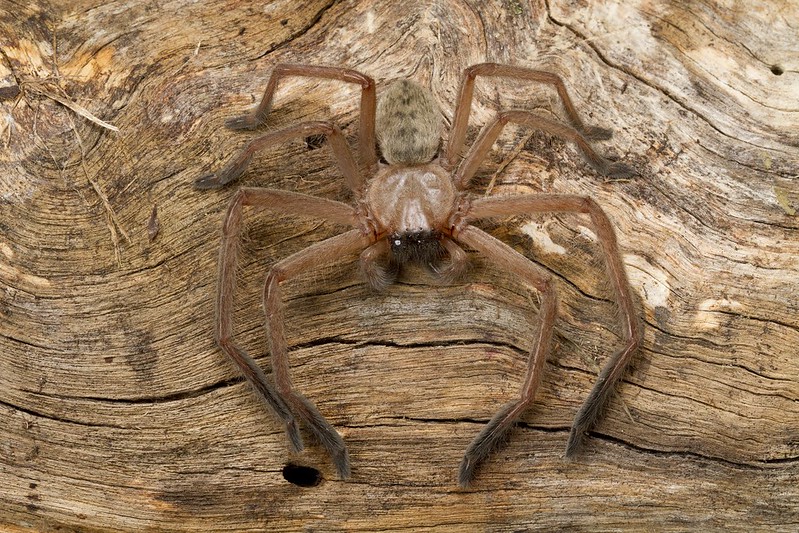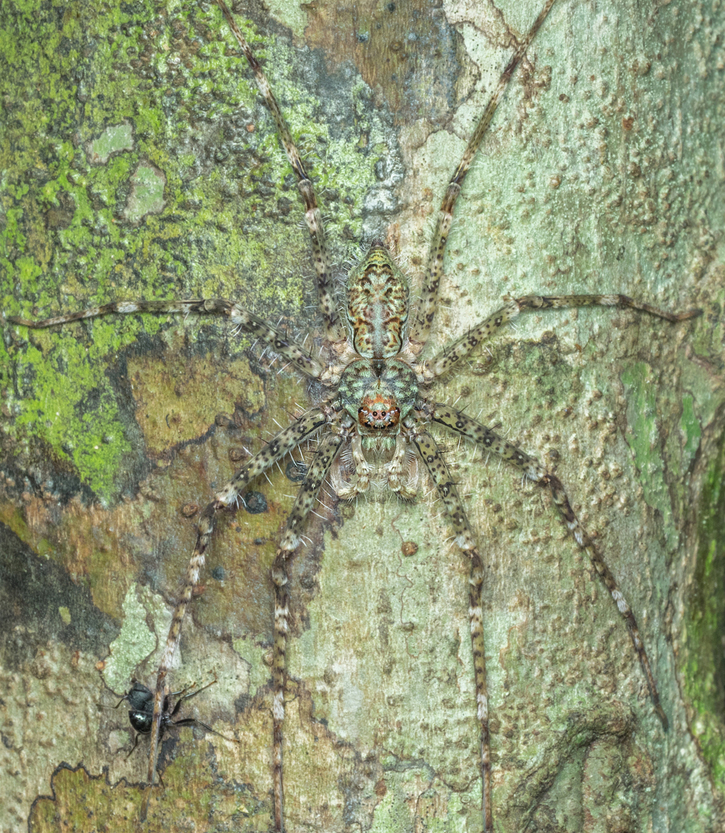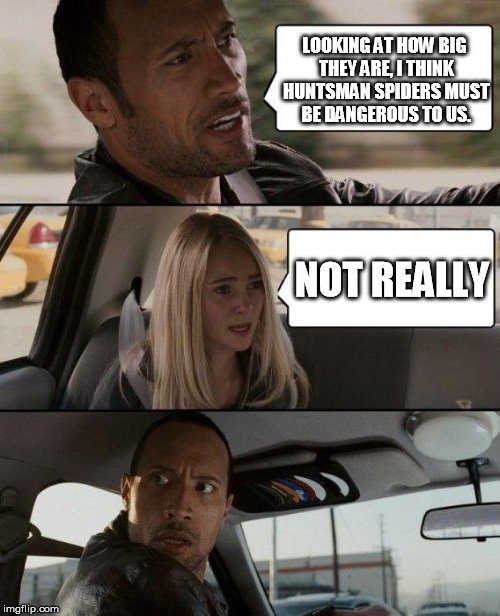A huntsman spider is a member of the Sparassidae family. They are particularly well-known for their giant size and their mode of hunting. Yes, huntsman spiders do bite humans occasionally, but their bites are not known to be dangerous to people (although they can be quite painful and have other side effects).
Spiders are scary and even a tiny one scampering up the wall can send anyone running out of the room. Now, imagine the same scenario, but the spider is as large as your palm. That terrifying sight would be the ‘Huntsman Spider’.
Their large, black and hairy appearance, with those eight eyes staring back at you… it’s no wonder that you would immediately want to flee, but the huntsman spiders suffer so much hatred and fear due to their nightmarish looks and size. In reality, they aren’t as scary as they are often made out to be.
Classification Of The Huntsman Spider
When it came to casting the radioactive spider that would bite Peter Parker in the first Spiderman film, they chose Delena cancerides, the Social Huntsman Spider.
Delena cancerides is part of a group of 1225 spiders that form a part of the family Sparassidae, the 11th largest spider family in the world. Australia and Asia are home to most of these giants. Australia appears to be afflicted from the spider’s terror more regularly, so they’re often called the Australian huntsman spider.

Besides being found in Australia, Huntsman spiders are also found in parts of Asia. They are found in the US as well, especially in subtropical areas of Florida, California and Texas, as well as in the coastal areas of Georgia and South Carolina. The Huntsman in America might have landed there from Asia via good old trading and routes for invasive species.
It was christened the ‘banana’ spider by those the spider surprised in banana markets, as it was oft to do. The last name is the same as many other underwhelming wood spiders, a large classification that are commonly found in woody places, like mine shafts, woodpiles, forested areas, and other woody places.
Also Read: What Is The Clock Spider And The Legend Surrounding It?
How Big Is The Huntsman Spider?
The huntsman spider is one of the biggest spider species on this planet. The spider’s body is about 2cm in lenth (or just less than an inch), but the spider’s legs can stretch as long as 15 cm (~6 inches). These long legs, instead of bending vertically with respect to their bodies like most spiders, spread out forward and laterally in a crab-like fashion, thanks to the twisted joints these spiders have. Some picked up on the resemblance of the spider’s sprawling legs to that of the crab and decided to call it the Giant Crab Spider.
These unusual leg joints are useful when the spider needs to hide away in a small nook, like between rocks and pebbles.
Huntsman spiders are generally grey or brown, and are sometimes found with banded legs. Many species of huntsman spiders have flattened bodies, possibly because they have adapted to live in narrow spaces, such as in rock crevices and under loose bark.

Due to their large size, you might mistake them for another notorious giant spider – ‘tarantulas’. Though quite similar to a casual observer, they belong to distantly related families. You can differentiate a tarantula from a Huntsman by how hairy the spider is. Huntsman spiders aren’t nearly as hairy as tarantulas, which look like very scary puffballs with legs.
Also Read: Venomous Spiders: What Are Some Of The World’s Deadliest Spiders?
Hunting Strategies Of The Huntsman Spider
Besides being giant, huntsman spiders are also fast. Their ability to run, along with their size, can be enough to instill even the bravest hearts with fear, but this speed also makes them master predators.
We associate spiders with stringy webs waiting to ambush their unsuspecting prey. The huntsman spider is not one of these types. In fact, there are many spiders that don’t create webs. There are only a few families of spider, like the daddy long legs or the orb weaver that create the elaborate webs we’ve come to broadly associate spiders with. Many spiders are actually adept predators, just like our huntsman.
Instead of lacing together a webbed trap, they prefer jumping and stalking their prey. Their speed, agility through their lateral legs, and their large, powerful size helps them catch their prey, mainly large insects like crickets.
Once they’ve caught their prey, they immobilize it with a venomous bite and perform a little ‘victory dance’. The Huntsman spider will ‘dance’ with its prey in its jaws (or chelicerae) and touch its spinnerets, the spider’s silk-weaving organ, to the ground. Their dance might mean that they’re binding their prey with spider silk, although the silk is too fine to be seen.
After the victory dance, the meal begins.
Though they look spine-chilling, Huntsman spiders are one of the good guys. Spiders like the huntsman are natural pest control agents. They eat insects that are human pests, like cockroaches, silverfish and crickets.
Do Huntsman Spiders Bite And Are They Dangerous?
Huntsman spiders do bite humans, occasionally, but their bites are not known to be dangerous to people (although they can be quite painful and have other side effects). Despite their sheer size and somewhat scary appearance, huntsman spiders are not known to cause harm to humans or be aggressive, and are therefore not generally considered dangerous.

The bite of a huntsman spider, however, can be fairly painful and result in local swelling. The effects of the bite vary, depending on the species of spider; their bites can also cause headache, nausea, vomiting and irregular pulse rate.
Though all spiders are venomous, only very few, like the ominous the black widow spider, cause fatal bites. Most spider fangs can’t puncture human skin, nor is their venom potent enough to cause humans any problems. It is merely adapted enough to immobilize their intended target – insects.
If threatened, a Huntsman spider will prefer to run away, rather than engage in combat, yet there are a few cases when huntsman spiders have been known to bite humans. The rarity of these bites indicates that they don’t bother humans, and as such, their bites are mostly incidental or accidental, such as in circumstances when you carelessly handle a pantropical huntsman spider or when you accidentally trap it with your bare hands nearby.
Fortunately, bites from these species don’t generally require hospital treatment. Another reason might be that the spider might be a female, which are known to defend their egg sacs and offspring more aggressively than males.
Spiders are widely misunderstood and misrepresented creatures. A classic case of ‘don’t judge a book by its cover’, spiders are mostly harmless to humans. In some cultures, spiders signify the opposite of disgusting; they’re symbols of good fortune.
In Egypt, people used place spiders next to the bed of a newly married couple, believing it would bring about good luck. Our aversion to spiders might have started some time in Medieval Europe, at a time when inexplicable plagues were ravishing the continent and all prolific insects and rodents were feared. Maybe it’s time to befriend the spider once more!
Test your knowledge on the huntsman spider

References (click to expand)
- Huntsman Spider, Heteropoda venatoria. The University of California, Irvine
- huntsman spider - Heteropoda venatoria (Linnaeus). The University of Florida
- Huntsman Spider Biology - titag. titag.org
- Whyte R.,& Anderson G. (2017). A Field Guide to Spiders of Australia. CSIRO Publishing
- Davey, G. C. L. (1994). The "Disgusting" Spider: The Role of Disease and Illness in the Perpetuation of Fear of Spiders. Society & Animals. Brill.
